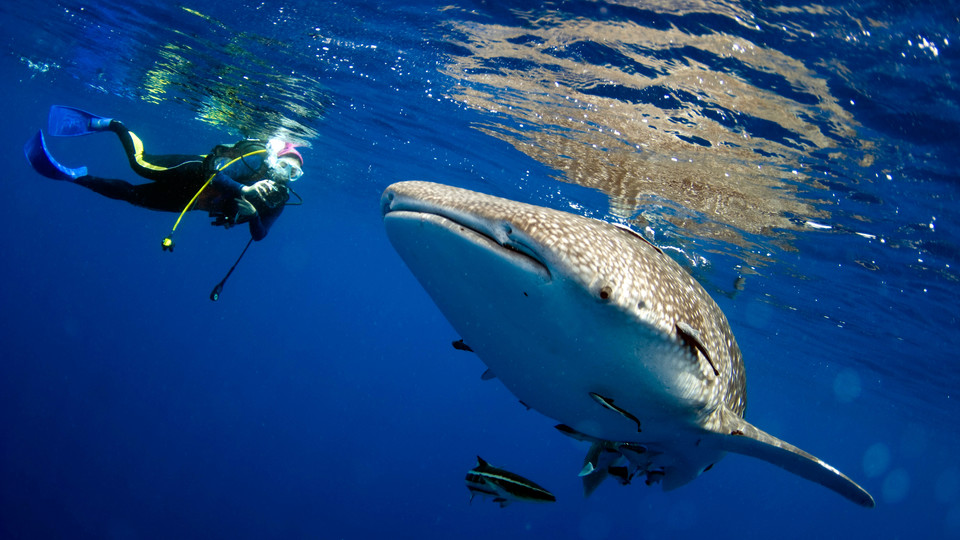· 6 min read
Could we engineer humans to swim as fast as sharks?

The fastest shark in the world is the Mako Shark, which can clock speeds of 60 miles per hour. Olympic gold medalist Michael Phelps's top speed is about 6 miles per hour. With the help of engineers, do humans have the capacity to close that gap?
Nebraska Today sat down with Timothy Wei, a mechanical engineer with expertise in fluid mechanics at the University of Nebraska-Lincoln, to ask.
Wei, Richard L. McNeel Professor of Engineering, has worked with dolphins and Olympic swimmers during his scientific career. In this discussion, he touches on his research, how he came to work with world class athletes and Navy dolphins and talks about what separates us from the creatures of the sea.
How did your background lead you to working with Olympic gold medalists?
In 2003, I was at Rutgers at the time, and one of our honors mechanical engineering students also happened to be an All-American swimmer. She was interested in the biomechanics of swimming.
I thought it would be fun to look at flow around swimmers. That’s what started that whole thing. She contacted USA Swimming, and got us connected to some world-class Olympic swimmers. We were able to do flow measurements around a number of gold medalists. Our goal was to try to understand how swimmers generate thrust, not just how they can reduce drag.
What has come out of that research?
We were able to help swimmers better their strokes and kicks in order to improve their times.
The research brought forth so much data and finding new and innovative ways to use that data is under way. That’s usually the biggest challenge: knowing what to do with all of that information.
I can drown you in data, but at the end of the day, as humans, there’s actually very little data that we can process – as amazing as our brains are. Right now, you need a coach who really understands the underlying science behind the data, at least in a conceptual or intuitive way. Not that a good coach will ever become obsolete, but there is value to developing techonologies with that data that will directly show a swimmer exactly what she or he needs to do to swim faster or longer. We working on that right now.
Moving on to sea creatures, how did you end up studying dolphins?
In my graduate school days and early faculty days, I had this idea in the back of my head, ‘wouldn’t it be cool to measure flow around whales?’
It was actually through connections I made during our research with swimmers, that I met Frank Fish, a marine biologist. We were at a meeting together a few years back and he said, ‘you measure flow around swimmers, you think you measure flow around dolphins? I’ve got access to a couple of retired Navy dolphins at UC-Santa Cruz.’ I jumped at the opportunity, because it was similar to being able to measure flow around whales.
What was learned from studying dolphins?
We were actually able to solve Gray’s Paradox. Dolphins can swim upwards of 22 to 25 miles per hour, but up until we performed our experiments, it wasn’t really understood how. In 1936, the zoologist James Gray did some analysis estimating the biological characteristics of the dolphin. He compared it to two guys rowing a boat and drew a conclusion that there’s no way a dolphin can swim as fast as it does, based on its physiology. The hypothesis was that there was something about the dolphin’s skin, called a compliant coating, that reduces the drag of the flow. Through the 20th century, especially during the Cold War, both the Russians and the United States spent millions of dollars studying dolphin skin and compliant coatings.
But our research shows that’s not the dolphin’s advantage. Dolphins actually generate powerful thrust. In our experiments, the trainer put her hand up to the water tank window and gave a direction. Primo, the dolphin, followed the direction, and swam away. Using columns of bubbles, we were able to measure the motion of the bubbles. Primo shed a vortex as he took off. We measured that vortex, used the aerodynamics theory and we showed that the thrust a dolphin generates is more than what’s necessary for it to go fast. We just published a second paper this year on the subject.
Would any amount of engineering allow humans to swim as fast as sharks, or dolphins?
No, we’re not designed to swim that way. We’re not streamlined. The shark and dolphin have streamlined bodies. In contrast, humans are what fluid dynamicists refer to as bluff bodies. Think about how hard it is to push a ball through water and think about the fact that your head is basically a ball sitting on your shoulders.
The dolphin has the right body shape for swimming and its body is designed with that wide tail. Beth Botsford has a great dolphin kick, but that’s as close as humans can get to swimming like dolphins. A dolphin’s tail is wide, and a human’s feet are small, so we just don’t generate that strong vortex, creating powerful thrust.
The fastest sharks have special scales that are diamonded-shaped. They’re similar to something used on America’s Cup sailboats called riblets. But again, those racing boats are designed with long, smooth streamlined surfaces. No amount of riblets on a human is going to allow them to swim as fast as a shark, because we just don’t have anything that’s in a nice, clean flow. We have no sizeable flat surfaces on our bodies.
We’re not at all as efficient as a dolphin or shark, and we’re not as fast as leopards, either. But we’re definitely not the slowest creatures in the animal kingdom. We’re actually a hybrid of a lot of things. It’s what’s between our ears that gives us the advantage over all other creatures.

Are you still working with swimmers or dolphins?
Not currently. Now we’re researching internal flows to study effects on vascular disease with colleagues at UNMC. We’re measuring flow over the individual endothelial cells that line your arteries. We’ve gone from big experiments to really, really tiny experiments, but the concepts of flow and drag are the same. We’re looking at how the flow affects the endothelial cells and how does that affect the biochemistry.











